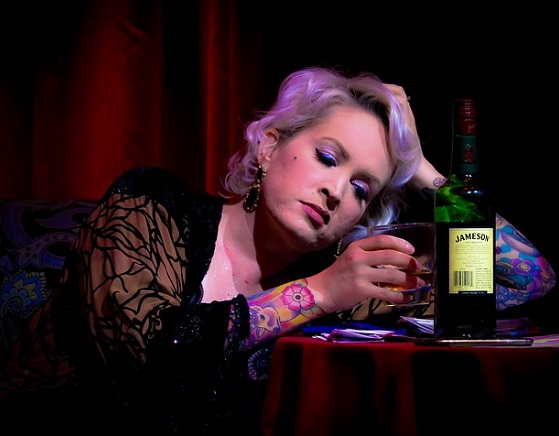5 Reasons Why Drug Rehab Is Harder for Women.

{source}
The opioid crisis doesn’t discriminate, so why is it so tricky for women to get help?
According to the National Institute on Drug Abuse, every three minutes a woman checks into an ER somewhere in the United States for prescription painkiller misuse or abuse. Around 4% of women in the US demonstrate symptoms of Alcohol Use Disorder in any given year, and over 20% of women engaged in binge drinking in the last month.
Oh, and there’s a buzzy new magazine devoted to women in the marijuana industry too.
In short, we know women are using, for better or for worse.
But, curiously, ladies are diagnosed with Substance Use Disorder (SUD) at only about half the rate of guys in the US.
Even more alarming: women only make up 30% of people in treatment.
Some argue that women are naturally more addiction-resistant, despite evidence that women become addicted to drugs of abuse more quickly than men, even when they use smaller amounts for a shorter period of time.
As a former substance abuse counselor, I started to sense that something was up with the gender disparity in addiction treatment. After delving deep into the research and talking to ladies affected by addiction, I found there are five big reasons why it’s more tough for women to get treatment.
Reason #1: Women’s Substance Abuse Patterns are Easier to Ignore
When we think of a stereotypical addict, we think of someone who is publicly hitting rock bottom. Oftentimes, this means showing up to work loaded, missing work, losing a job, getting arrested, or wrecking a car. You’ll see these same signs of rock bottom repeated in a lot of addiction literature — it’s even in the stuff designed to train counselors to spot the hallmarks of addiction.
Can these consequences of addiction apply to women? Certainly. Women can and do face all of these consequences of addiction everyday.
However, a large percentage of women don’t work outside the home, which means that these classic signs of addiction won’t always apply. For women who work inside the home, there are fewer witnesses to the increasingly out-of-control behavior associated with a spiraling addiction. Frequently, these women are able to hide their addiction from everyone, including their close family.
To make matters worse, an addict is likely to be surrounded by people at home who tolerate, ignore, or even enable their behavior.
Without the additional eyes of coworkers, colleagues, and supervisors, women who work inside the home can easily pass their addiction under the radar, making treatment less likely.
Reason #2: Being a Caregiver Makes It Hard to Take Care of Yourself
It’s no secret that women shoulder most of the burden for caregiving in our country. Sure, women are socialized to be more caring than men, but there’s definitely more to this trend.
Because women are systematically paid less than men, and because they face more gender-related obstacles in nurturing fulfilling careers, it often makes more sense financially for a family to choose to have a woman stay home and do the unpaid labor of caregiving. This important, uncelebrated work ranges from caring for children, to nursing the elderly, to assisting the disabled.
When a woman with caregiving responsibilities is suffering with addiction, it is much more difficult for her to seek treatment, and often impossible for her to enroll in residential treatment. While there are a few programs that allow women to attend with their children, the need for such treatment far outweighs program availability.
While employers sometimes allow unpaid leave or even paid time off to attend treatment, no such amenities are available to women with unpaid caregiving roles.
Even when a replacement is available — in the example of a relative or friend volunteering to take over caregiving responsibilities for the duration of treatment — many women don’t feel comfortable leaving their children (or other caregiving recipients, like elderly parents) in the care of others.
This is a massive barrier to treatment for many women.
Reason #3: Babymaking While Addicted is Still a Crime in Many States
While men active in their addiction face no consequences for procreating, women are exposed to criminal charges in many places for simply getting knocked up while using. So-called chemical endangerment and fetal assault laws disproportionately affect highly policed populations, like women of color and women experiencing poverty.
Women who get pregnant while addicted can face jail time if their baby is born with signs of maternal drug abuse.
Rather than curb drug use in addicted women, these laws result in dangerous behaviors for both mother and child. In states with these punitive laws, some women resort to giving birth without medical assistance, crossing state lines while in labor, abandoning their babies immediately after birth, avoiding post-natal care, or choosing unwanted abortions, all in an effort to avoid criminal charges.
Clearly, the compelling need to employ these evasive maneuvers to avoid jail time makes it far less likely that a woman will choose treatment if she is pregnant in states with chemical endangerment laws. Women in these circumstances need help, not punishment.
Reason #4: Most Treatment Programs Were Designed by Men for Men
Addiction, for many years, was perceived as primarily a male problem. It should come as no surprise, then, that the addiction treatment industry was pioneered by men, in service of (mostly) other men.
Early efforts to address addiction — inebriate homes, asylums, drunk tanks, alcoholism cures — were all designed for men. In 1939, when The Big Book was first published, the idea of addiction as a disease began to germinate. Although The Big Book and AA have helped many women get sober, the program was designed by men with a mostly male audience in mind.
Much has been said about the problem of sexism in mixed-gender 12-step programs. Many women find the seemingly pure concepts of fellowship and mutual aid espoused in 12-step programs muddied with unchecked sexism, unwelcome advances, and abuses of the sponsor-sponsee relationship.
The so-called 13th step — where men with clean time use the program to systematically seek out freshly sober young women — is an unwritten reality of the program. Because of the leaderless nature of the fellowship, there is no codified system for addressing these bad actors.
While all-female meetings might help address this problem, the feeling that the program was designed as a boys’ club remains for many women.
Reason #5: Most Evidence-Based Treatment Is Based on Studies of Men
As with other types of medicine, addiction medicine is not free of inherent gender bias. Although addiction medicine has improved over the last few decades with an increasing focus on evidence-based treatment, all too often this evidence is collected using an all-male participation sample.
Why is this a problem? Because we know that women’s bodies react to addiction, treatment, and recovery differently from men’s bodies. Especially in medication-assisted treatment, where pharmaceuticals are used to help with recovery, it’s important to specifically measure the safety and efficacy of the medicine for women’s bodies. All too often, these studies are simply not being done.
It’s Time to Prioritize Women’s Recovery
Women clearly face a lot of barriers to treatment that men just simply don’t have to deal with. I saw this again and again in my own work as a substance abuse counselor. Childcare duties got in the way of my clients’ appointments, and school drop-offs interfered with group attendance.
Women who needed help went for years without being recognized and diagnosed because they weren’t facing consequences in a traditional 9-to-5.
When women don’t work outside the home, they are more likely to have their addiction fly under the radar. When women are saddled with caregiving responsibilities, they are less free to seek the treatment they need. When women are punished for their reproductive function, access to treatment suffers.
When women are forced into treatment programs that fail to address their unique experience, they are unlikely to thrive. When women don’t have access to evidence-based treatment that takes into account the well-being of their bodies, they are denied the same level of care available to men.
Women’s addiction is systematically invisibilized, ignored, criminalized and trivialized. It’s time we as a country start prioritizing women’s recovery. After all, we are over 50% of the population. We deserve access to good, reliable treatment too.
***
Erin Gilday is an author, activist, and former substance abuse counselor. She likes classic cars, industrial sewing machines and The X-Files. She’s a copywriter at Little Light Copywriting, where she specializes in copy and content marketing for addiction treatment providers. You can find her on LinkedIn.
***
{Join us on Facebook, Twitter, Instagram & Pinterest}

